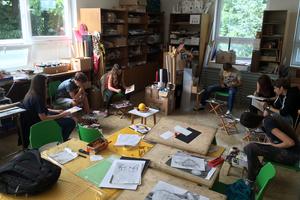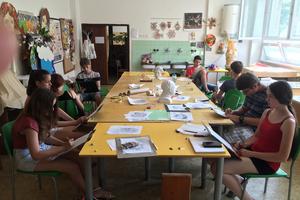Despite leaving Russia due to what he calls “stupidity” and starting in the United States with little money and no knowledge of language, artist Grigory Gurevich has high spirits. He shares what he called “life philosophy” among students attending his art lessons in the United States, but also in the small western Slovak town of Šamorín, where he visits in the summer.
The Slovak Spectator was talking with Gurevich about his students, his love to art and pantomime, his beginnings in the United States and his brief appearance in popular television series Law & Order.
The Slovak Spectator: What brought you to Šamorín for the first time?
Grigory Gurevich (GG): My ex-wife Erika Wittmann was born in Biskupice. When we came to Slovakia one summer with our son Alexander, her mother found in newspaper an advertising about a Hungarian camp in a village close to Šamorín. She contacted someone, who handled participants and this is how my son was signed to a camp in Gabčíkovo. The following year I was invited to join him and there I met Irenka [Irena Szűcsová, current head of the music and art school in Šamorín – ed. note], because Alex became friends with her son Gábor. There Alex and I performed pantomime for children and I made some workshops on sculpture. When Irenka became director of the school several years later, she decided to apply for a grant for me to teach art classes here. That was about six or seven years ago.
TSS: What persuaded you to return every year?
GG: I wanted to help students progress quickly, to share with them some important basic knowledge I have, so they will be able to pass examination if they decide to go to art institution. Here I can concentrate on few tasks only, like drawing, painting or writing. In the United States I’m busy with many other things. For example, one year I concentrated on writing my stories. I wrote maybe 36 short stories in a single day and later made a book titled “Allegories”. Another summer I took one of my short stories and extended it into a fairy tale. I also partially illustrated it here, and then published a book in the US. This time I am not travelling around much, so I brought some writing to finish.
TSS: What are your students like?
GG: I’m a lucky person, because all students I’ve had in the United States and in Russia were absolutely fantastic. I cannot say which students are better, they are all great people. I teach different ages and I have good communication with all of them.
TSS: Are there any differences in your students here?
GG: I suggest them to ask me different questions. But they don’t, not in the United States, not here. Probably when I teach them I answer all their questions during my class. This is how I teach. When people come through the corridor to my class, there is absolute silence. On a distance someone may think nobody is there. But everybody just sits and works. I explain my assignments and always make my demonstration as an example. After that it’s mostly action.
TSS: Why did you decide to start teaching?
GG: The more I progress, the more I want to share with people. I want to give them what I know. I started pantomime as a director and a creator back in Russia. I was 24 years old, influenced by Marcel Marceau [famous French actor and mime – ed. note]. I decided to gather more people to extend myself. Because when you teach the students, they become your instruments, the continuation of your body and mind. Now, when I come to Russia, to my ex-students, we meet like a family.
TSS: Do you still perform pantomime?
GG: Not very often. I spent about 15 years in the United States doing pantomime, but it’s a different culture. Many mimes wanted to make money very quickly and after their studies they went to the streets to perform simple tasks or just standing still like a statue. That was disgrace to pantomime. Even some greatest mimes of all came to the United States to perform in theatre and failed. Marcel Marceau once supposed to have 18 performances in New York, but he did 15 or 16 instead and cancelled the rest. [Henryk] Tomaszewski of Poland had a fantastic theatre of 30 trained actors. When they came to St Petersburg to perform, police on horses were guarding the theatre because people wanted to see their pantomime play. But when they came to the United States, they couldn’t make money to tickets to fly back to Poland. Pantomime is not considered a professional form of theatrical art in the United States.
TSS: Why do you find pantomime so interesting?
GG: It is really an incredible form of art. First of all, pantomime must be absolutely pure, clear, isolated from speaking. It is a great form of art because real instinct of human being is based on silence. You can recognise a person by looking at his or her eyes, the movement of the body. It uses a universal language which everybody, including animals, understands.
TSS: When did you realise you want to devote your life to art?
GG: I was little, maybe five years old, when my father came over and drew something for me. It was during the war and I did not see him very often because he was a camouflage artist in an army. Before the war he was working as theatrical stage and costumes designer and later he became an architect. I guess I have his genes in my blood: what our parents do, sometimes we pick up. I was interested in drawing and started to draw. I have studied art my whole life. When I became student of Muchina School in St Petersburg, a very famous and good one, we had to study painting very seriously. Now when people study architecture, they use computers.
TSS: You left Russia and started a new life in the United States, without even knowing a language. Has it somehow reflected in your work?
GG: I’ve never taken it as difficulties. I left Russia because of bureaucracy, because of stupidity of people who led the country and didn’t value their own people that are progressive and open-minded. I was completely against it. The government should be smart, intelligent, progressive. But if government is stupid and people are smarter than it, that’s not good.
This situation affected my work. I had pantomimes in protest to that. They were received very well by people, but the government put their foot down and stopped my company.
TSS: Was it hard to start in a new country, especially with having only a little money? How did you manage?
GG: I managed it well, because my spirit was high. For two years I was vegetarian by situation. I did not have money to buy meat. But when I stopped eating meat and fish, I could not get up from a bed in the morning. My heels were in pain and even standing on legs was difficult. I immediately started eating fish and slowly pain passed away. In fact, I do not have problems with eating. As a child I was limited with food, but we, children, didn’t know it. We took whatever we received. Limitations are good for people because they teach them to be economical. I don’t waste anything, including materials. I prefer to share what I have with people. It’s a philosophy of life: recycling.
TSS: Do you sometimes return back to Russia?
GG: Yes, of course. Now it’s not restricted. I’ve had several art shows in Russia in different cities. One of my ex-students is now in Kazan and is head of the art union there. We are communicating via Facebook, which has become part of my family. I have about 1,000 friends on Facebook all of whom I know. I have friends all around the world.
TSS: How do you feel about Russia now? Do you still call it home?
GG: If you have family, you are welcome everywhere. As I said, my ex-students are my extension; they are part of my family. I can go to any place and be welcomed. It’s like picture and frame: you can change frame, but picture stays the same.
TSS: You acted in an episode role in Law & Order series. How did you get the job?
GG: After few years I became member of the Screen Actors Guild where you can get some parts in movies if you are selected after audition. But competition for acting in the movie is very difficult in the United States. After I was able to buy my own car, about 1.5 years after I came, I used it as a car service. I also renovated furniture or anything that could be renovated, because I’m very good with tools. But I didn’t know how to price my work, so I was setting a very low price. I had to work very hard, and made a lot of mistakes. But I have lots of funny stories. For example, one man gave me Egyptian silver bracelet to repair. It had a small hole, but instead I burnt it. So I had to cast a new piece. He didn’t recognise it. But I spent tremendous amount of time and additional money, not earning a cent.
As for the episode, the director was Bulgarian, a European person to my luck. He started talking to me and found out I was a mime. He asked me whether I know Marcel Marceau and I told him we are friends. He asked me whether I know he had one movie, and I interrupted him saying “You mean the movie where he said one word?” And he told me I was getting one part where I will say only one word: “Da” [yes in Russian – ed. note]. So in my episode they put me in handcuffs, asked about my name, and after I said "Yes", they put me in a car and drove me to prison.
TSS: You have invented a new type of manifold book. How did you come to this idea?
GG: When the war with Germany was over, my mother brought me to the market in Chelyabinsk. We came to one man who was selling double-fold books. When I was maybe eight years old, I decided to repeat it myself. And I figured it out. Then in 1985 I came back to that idea and figured out how I can make it open in many different ways. At that time I thought it was an excellent idea and I patented it. But I’ve never made money on that.
TSS: What other things have you invented?
GG: When I was in Russia I invented machine for burning the surface of wood for interior design that was my first patented invention, but I was in a company at that time. It absorbed all expense relating to patent. The magic book is an individual invention, so I had to pay for a submitting a patent. If you want to make mass production, you have to find manufacturers to produce it. I tried it, I wrote letters to some companies which produce toys, Lego for example. But some of them wrote me back, saying I have to pay them $100 for them to look at the book. So I didn’t sell it, I just show it to others.
My patent is over now because it runs only for 15 years. Anybody can now do it as it’s public domain. There are people who tried to go over my patent but they don’t go much further. They sell few thousands of the toys, but that’s it because they are limited. My idea is unlimited.
TSS: You are a mime, a painter, a sculptor, an author, an inventor and a teacher. In which role do you feel the best?
GG: In all of them. All what I do is part of creativity. It’s like having a child: you bring this child up, pay attention to how it grows, spend time with it, bring it to the level of being good human being. It’s the same with ideas. You have to bring each idea to the top. It means you work very hard. Sometimes you don’t sleep enough. This is why I don’t read newspapers, don’t watch television. If you have something inside, you have to put it out, give it away to people, let them use it. I don’t want to be a receiver, I want to be inventor. Life is too short to just watch television.
Who is Grigory Gurevich
Gurevich was born in 1937 in St Petersburg, Russia to a Jewish family. At the beginning of World War II he and a small group of children were evacuated to Siberia. His work was first exhibited in the United Exhibit of Artists in Moscow when he was 15, and he went on to study art, graduating from the Academy of Fine and Industrial Arts of Saint Petersburg in 1961. Inspired by a performance by Marcel Marceau in St Petersburg, he spent eight years studying pantomime, creating his own professional group in 1966 – the first professional mime company in Russia. It later merged with the State Theatre of Satire, run by Arkady Raikin.
After splitting with Raikin three years later, he faced increasing censorship from Soviet authorities over the philosophical nature of his performances. This resulted in him leaving for the United States in 1976, aided by the Hebrew Immigrant Aid Society (HIAS) and Niana – groups that helped Jews emigrate. He became a citizen of the United States in 1984. He is well known for his sculpture, with his most famous work being The Commuters, sculptured in 1985. He now lives in New Jersey.



 Grigory Gurevich surrounded by his students. (source: Slávka Bulíková)
Grigory Gurevich surrounded by his students. (source: Slávka Bulíková)


